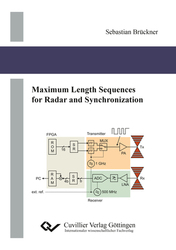| Departments | |
|---|---|
| Book Series (96) |
1378
|
| Nachhaltigkeit |
3
|
| Gesundheitswesen |
1
|
| Humanities |
2364
|
| Natural Sciences |
5406
|
| Engineering |
1793
|
| Engineering | 292 |
| Mechanical and process engineering | 862 |
| Electrical engineering | 686 |
| Mining and metallurgy | 30 |
| Architecture and civil engineering | 75 |
| Common |
98
|
|
Leitlinien Unfallchirurgie
5. Auflage bestellen |
|
Advanced Search
Maximum Length Sequences for Radar and Synchronization (English shop)
Sebastian Brückner (Author)Preview
Extract, Datei (800 KB)
Table of Contents, Datei (570 KB)
This dissertation demonstrates the implementation of ultra-wideband (UWB) radar sensors using commercial off-the-shelf electronics. The sensors are based on the correlation of binary pseudo noise sequences (M-sequences), combining low transmit power requirements with excellent noise and interference suppression.
A ranging system is introduced that is able to track moving objects with a standard deviation of 1.73mm at 2m range. Subsequently, a system is developed which can synchronize itself to a reference sequence with 1.96ps RMS jitter. This synchronization system uses an analog correlating control loop (delay lock loop) to achieve tracking of the reference to 0.38% of one chip.
The final application shown is a ground penetrating radar (GPR). The system is comprised of three elements: an FPGA, an output driver for the transmitter and a commercial analog-to-digital converter. Comparative measurements on buried pipes and cables prove that this system has achieved detection capability comparable to commercially available pulsed GPRs.
| ISBN-13 (Hard Copy) | 9783736991927 |
| ISBN-13 (eBook) | 9783736981928 |
| Final Book Format | A5 |
| Language | English |
| Page Number | 158 |
| Lamination of Cover | matt |
| Edition | 1. |
| Publication Place | Göttingen |
| Place of Dissertation | Braunschweig |
| Publication Date | 2016-01-29 |
| General Categorization | Dissertation |
| Departments |
Electrical engineering
Telecommunications and communications engineering |
| Keywords | ground penetrating radar, delay lock loop, synchronization, m-sequence, prbs |








